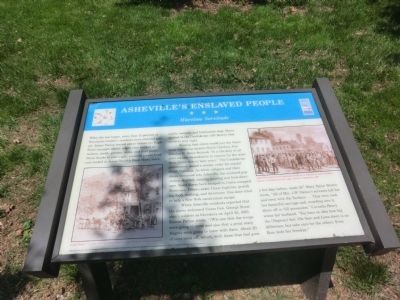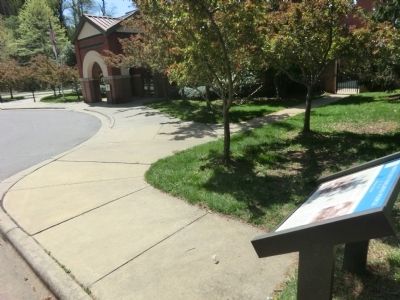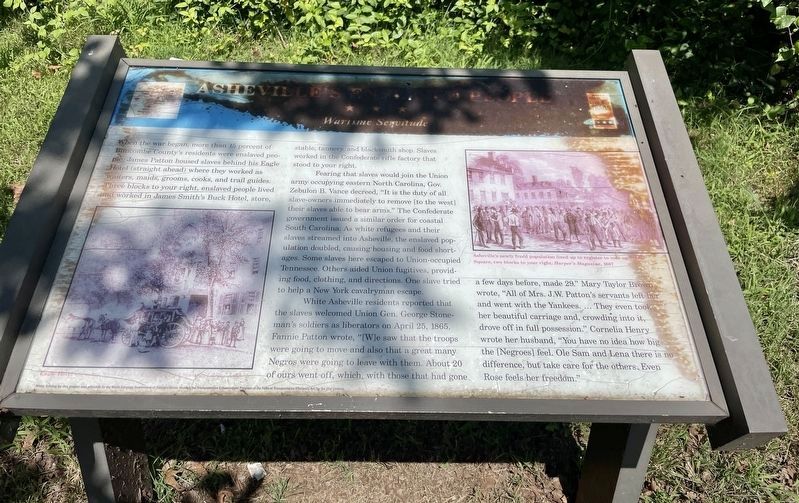Asheville in Buncombe County, North Carolina — The American South (South Atlantic)
Asheville's Enslaved People
Wartime Servitude
Fearing that slaves would join the Union army occupying eastern North Carolina, Gov. Zebulon B. Vance decreed, “It is the duty of all slave-owners immediately to remove (to the west their slaves able to bear arms.” The Confederate government issued a similar order for coastal South Carolina. As white refugees and their slaves streamed into Asheville, the enslaved population doubled, causing housing and food shortages. Some slaves here escaped to Union-occupied Tennessee. Others aided Union fugitives, providing food, clothing, and directions. One slave tried to help a New York cavalryman escape.
White Asheville residents reported that the slaves welcomed Union Gen. George Stoneman’s soldiers as liberators on April 25, 1865. Fannie Patton wrote, “(W)e saw that the troops were going to move and also that a great many Negroes were going to leave with them. About 20 of ours went off, which, with those that had gone a few days before, made 29.” Mary Taylor Brown wrote, “All of Mrs. J.W. Patton’s servants left her and went with the Yankees. …They even took her beautiful carriage and, crowding into it, drove off in full possession.” Cornelia Henry wrote he husband, “You have no idea how big the (Negroes) feel. Ole Sam and Lena there is no difference, but take care for the others. Even Rose feels her freedom.”
(captions)
(lower left) Eagle Hotel - Courtesy North Carolina Collection, Pack Memorial Library, Asheville
(upper right) Asheville’s newly freed population lined up to register to vote on Public Square, two blocks to your right. Harper’s Magazine, 1867
Erected by North Carolina Civil War Trails.
Topics and series. This historical marker is listed in these topic lists: African Americans • War, US Civil. In addition, it is included in the North Carolina Civil War Trails series list. A significant historical month for this entry is April 1865.
Location. 35° 35.606′ N, 82° 32.928′ W. Marker is in Asheville, North Carolina, in Buncombe County. Marker can be reached from the intersection of Eagle Street and Davidson Drive, on the right when traveling east. The marker is in the north parking lot of the Asheville Public Works building. Touch for map. Marker is at or near this postal address: 161 S Charlotte St, Asheville NC 28801, United States of America. Touch for directions.
Other nearby markers. At least 8 other markers are within walking distance of this marker. Lynching in America / The Lynching of Bob Brackett (about 500 feet away, measured in a direct line); Isaac Dickson and the Historical East End Neighborhood (about 500 feet away); Catholic Hill School (about 500 feet away); Isaac And Delia Dickson (about 500 feet away); "The Block" (about 600 feet away); Ashe Monument (about 700 feet away); Brick Artisan (about 700 feet away); Hotel District (about 700 feet away). Touch for a list and map of all markers in Asheville.
Credits. This page was last revised on July 29, 2023. It was originally submitted on July 20, 2014, by Don Morfe of Baltimore, Maryland. This page has been viewed 893 times since then and 42 times this year. Photos: 1, 2. submitted on July 20, 2014, by Don Morfe of Baltimore, Maryland. 3. submitted on July 29, 2023. • Bernard Fisher was the editor who published this page.


